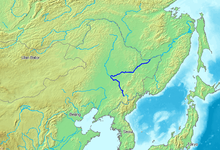Sungari River
| Songhua River | |||||||

Songhua River is shown in a darkish blue color.
|
|||||||
| Chinese name | |||||||
|---|---|---|---|---|---|---|---|
| Chinese | 松花江 | ||||||
|
|||||||
| Alternative Chinese name | |||||||
| Chinese | 海西 | ||||||
|
|||||||
| Manchu name | |||||||
| Manchu script | ᡠᠩᡤᠠᡵᡳ ᡠᠯᠠ | ||||||
| Romanization | Sunggari Ula | ||||||
| Transcriptions | |
|---|---|
| Standard Mandarin | |
| Hanyu Pinyin | Sōnghuā Jiāng |
| Transcriptions | |
|---|---|
| Standard Mandarin | |
| Hanyu Pinyin | Hǎixī |
The Songhua River (also Haixi or Xingal, formerly Sunggari) is one of the primary rivers of China, and the largest tributary of the Amur River. It flows about 1,434 kilometres (891 mi) from the Changbai Mountains on the China–North Korea border through China's northeastern Jilin and Heilongjiang provinces. The river drains 1,443,100 square kilometres (557,180 sq mi) of land, and has an annual discharge of 2,463 cubic metres per second (87,000 cu ft/s).
The extreme flatness of the Northeast China Plain has caused the river to meander widely over time. The result of the meandering is that the river is surrounded by a wide plain that is filled with swirls and curves, showing paths the river once took.
As the Second Songhua River, it joins the Amur at Tongjiang, Heilongjiang. It is then interrupted by the Baishan, Hongshi and Fengman dams, which are used for hydroelectricity production. Fengman Dam forms a lake that stretches 62 kilometres (39 mi) upstream. Below the dam, the Second Songhua flows northwest until its largest tributary, the Nen River, joins it near Da'an and creates the Songhua. The Nen River drains the Songnen Plain. The river travels east until it joins the Hulan River near Harbin. Nearby it is also joined by the Ashi, which gave its name to the Jurchen Jin Dynasty (12th–13th century). Then it passes between the northern end of the eastern Manchurian mountain system and the Lesser Xing'an Range. The river then flows into the Amur River (Heilong Jiang) valley. The river freezes from late November until March. It has its highest flows when the mountain snow melts during the spring thaw. The river is navigable up to Harbin by medium-sized ships. Smaller craft can navigate the Songhua up to Jilin and the Nen River up to Qiqihar.
...
Wikipedia
